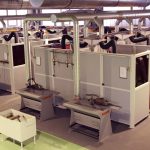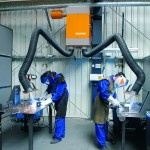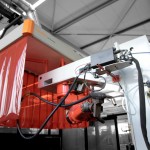Extraction arm: ten facts for ideal properties when extracting welding fumes
An extraction arm must capture welding fumes directly at the point where they arise. Yet welders are not always content with the handling, especially when tracking. In an ideal case, however, an extraction arm helps welders with their work: here are ten facts on how an extraction arm needs to be procured.
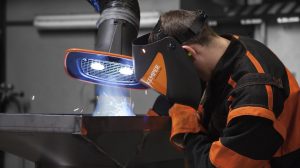 In welding operations, an extraction arm is a key choice much of the time when it concerns point extraction. And this is exactly what is recommended for effective extraction of welding fumes. Point extraction captures the welding fumes directly at the source where they occur, without them escaping into the air in the hall. Compared with other types of extraction, such as point extraction integrated in the welding torch or high vacuum point extraction, low vacuum point extraction using an extraction arm has a larger extraction radius and is positioned further away from the source. Depending on the shape and size of the extraction hood, welding fumes can still be captured adequately at a distance of up to 30 to 40 centimeters.
In welding operations, an extraction arm is a key choice much of the time when it concerns point extraction. And this is exactly what is recommended for effective extraction of welding fumes. Point extraction captures the welding fumes directly at the source where they occur, without them escaping into the air in the hall. Compared with other types of extraction, such as point extraction integrated in the welding torch or high vacuum point extraction, low vacuum point extraction using an extraction arm has a larger extraction radius and is positioned further away from the source. Depending on the shape and size of the extraction hood, welding fumes can still be captured adequately at a distance of up to 30 to 40 centimeters.
With an extraction arm, everything depends on the right properties
But extraction arms are to some extent fundamentally different in their properties. This means they are often too impractical for the user and tracking is too difficult. However good the technology, it is to no avail if it isn’t used! The extraction arm should be designed to help the welder. Care should therefore be taken to choose the right fittings. The following overview shows what the decision for an extraction arm depends on.
Here are ten facts about an extraction arm for effective extraction of welding fumes
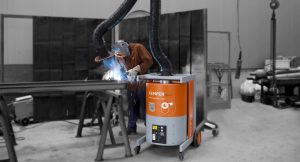 Flexibility: Flexibility is where it starts and ends when extracting welding fumes with an extraction arm. Flexible and easy settings fundamentally ensure a high work rate, despite occasional tracking. Handling is also immensely important for acceptance by the welder.
Flexibility: Flexibility is where it starts and ends when extracting welding fumes with an extraction arm. Flexible and easy settings fundamentally ensure a high work rate, despite occasional tracking. Handling is also immensely important for acceptance by the welder.
- Ease of operation Ease of operation when tracking the extraction arm is crucial for a high degree of flexibility. Consider this: The welder must concentrate on his actual task. With his welding torch in his hands, he could do without having to put it down beside him and stop work merely to track the extraction arm. Against this background, ease of operation means being able to track the extraction arm simply with one hand without a lot of effort. The set position should be freely selectable and finally, capable of staying in position permanently.
- Self-supporting: If the extraction arm needs tracking, it should still remain in the open air just as the welder has positioned it. If the extraction arm moves independently – and this may be only a few centimeters – into another position, because its properties do not allow differently, the welder has yet another task which distracts him from his work. The extraction arm should therefore be capable of holding its position without external support, for example by internal supporting rods. The extraction arm should be capable of maintaining its position at all times. This depends mainly on the quality of the springs.
- Flexible extraction hood: The extraction hood connected to the extraction arm makes a crucial contribution to the quality of the work. It also aids flexibility. Capable of rotation through around 360 degrees, the welder is able to set the extraction arm in any position he decides. A robust handle also helps.
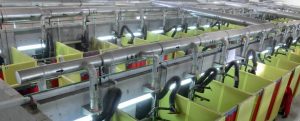 High capture range: The shape of the extraction hood is crucial in determining the height of the capture range. The welder should ensure flange-shaped properties. In contrast to oval extraction hoods, the flange shape is aligned along the longitudinal seam of the weld. This means that less false air is sucked into the sides and the extraction arm captures 40 percent more welding fumes along the seam. This also means that the welder does not have to track the extraction arm so often.
High capture range: The shape of the extraction hood is crucial in determining the height of the capture range. The welder should ensure flange-shaped properties. In contrast to oval extraction hoods, the flange shape is aligned along the longitudinal seam of the weld. This means that less false air is sucked into the sides and the extraction arm captures 40 percent more welding fumes along the seam. This also means that the welder does not have to track the extraction arm so often.
- Lighting: Even the lighting system offers more convenience while welding. This can be incorporated in the extraction hood. LED lighting provides ideal visibility of the job. This leads to better welding results. Because of this sensible aid for the actual work in itself the welder should be interested in tracking the extraction arm constantly. This again affords effective protection while working.
- Large quantities of dust and smoke: An extraction arm is designed with properties that enable it to extract large quantities of dust or smoke.
- Ergonomic workstation: The flexibility and ease of operation of extraction arms not only facilitates fast and simple adjustment. The welder can also set the flexible, self-supporting extraction arm ideally to his own build and working position. In addition, an extraction arm does not demand any room in the actual workplace, as it remains self-supporting in the air.
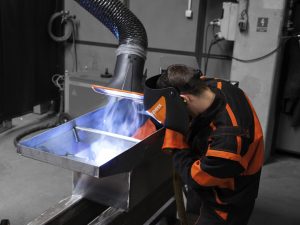 Variable lengths: In general, an extraction arm is available in different lengths – usually, from two to ten meters. Selection of the length depends crucially on the features of the workstation. When machining large jobs, a long extraction arm is advisable. Rigid, but rotating booms, that are designed individually to the dimensions of the extraction arm, support it while it continues to hold itself in the air. It is advantageous if the boom can absorb loads such as tools or wire feed systems. By hanging it, the risk of tripping is also reduced and safety in the workplace improved.
Variable lengths: In general, an extraction arm is available in different lengths – usually, from two to ten meters. Selection of the length depends crucially on the features of the workstation. When machining large jobs, a long extraction arm is advisable. Rigid, but rotating booms, that are designed individually to the dimensions of the extraction arm, support it while it continues to hold itself in the air. It is advantageous if the boom can absorb loads such as tools or wire feed systems. By hanging it, the risk of tripping is also reduced and safety in the workplace improved.
- Variable operating areas: An extraction arm can be used in a very wide variety of working environments, whether these be closed areas and welding cabins or open spaces. It can be connected to fans, stationary equipment or via pipelines to a central extraction or filter unit.



